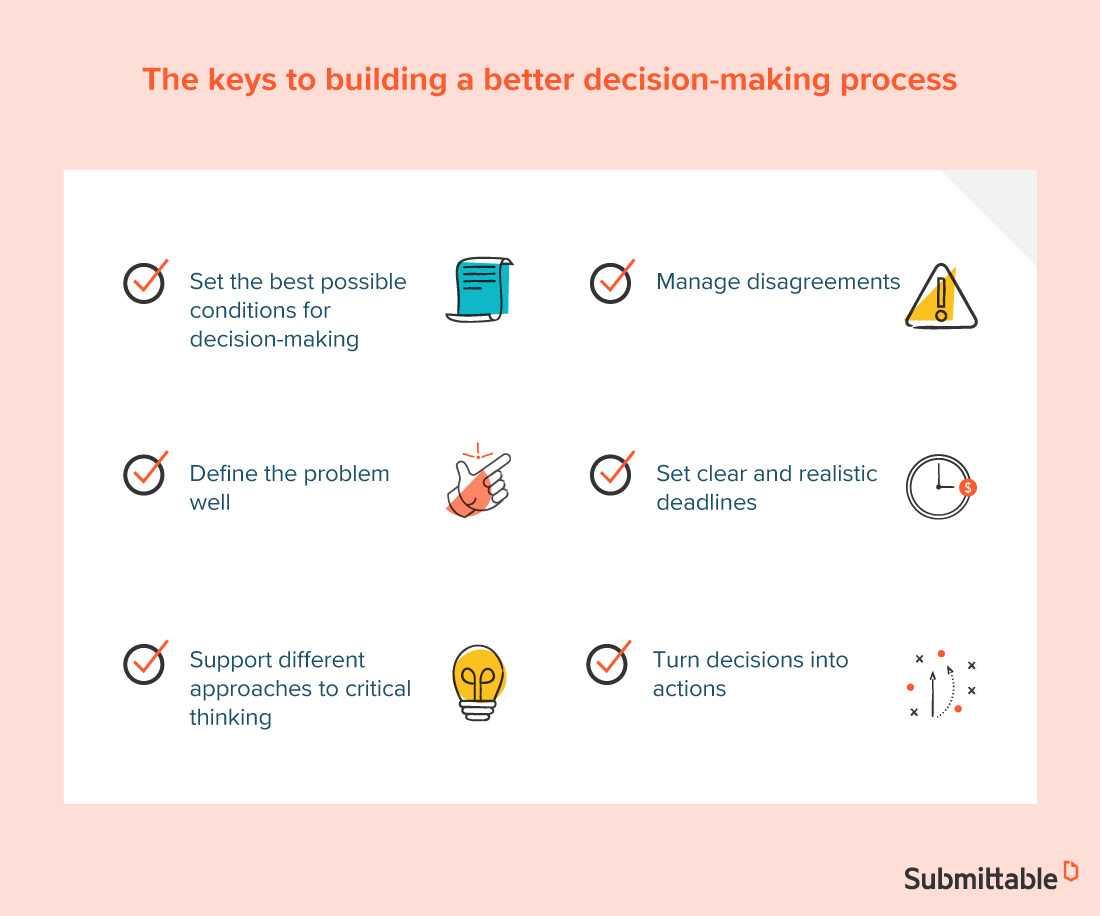Let’s start by clearing the air: Group decision making doesn’t have to be painful.
Done right, it can be downright invigorating and wildly successful. With the right team and a good process for reaching decisions, the power of groups can be tremendous.
Don’t forget what Margaret Mead said about group decision-making: “Never doubt that small groups of committed citizens can change the world. Indeed, it’s the only thing that ever has.”
Even still, it’s important to go into group decision-making focused on how to make it work.
What voting method(s) will the group use (if any)?
Is the group striving for consensus? Why or why not?
Which conditions will you set for the group to maximize the chances for success?
Tackling such questions at the outset is critical when structuring decision-making processes for groups. Weighing the advantages and disadvantages of various methods for negotiating group decision-making will allow you to optimize the process.
In other words, deciding how the group decides is likely the toughest decision you’ll face. Tough but not impossible—here are some tools and strategies to get it right.
How some of the top companies approach consensus-building
First, three short stories about how consensus-building and group decision-making have played out in the real world.
A number of America’s most well-regarded CEOs both moved their very companies away from consensus-driven cultures. When Larry Page took the reins at Google in 2011, he deemed that every meeting needed a single decision maker—otherwise the meeting should not occur. Page even went on to declare that there are “no companies that make good slow decisions,” a nod to the idea that consensus-building can be a drag on business timelines.
At Amazon, Jeff Bezos urged his employees to avoid chasing agreement and to trust each other by gambling on various options together even when disagreements remained. Bezos notes that “high-velocity decision-making” is one of the keys to Amazon’s success. In business, getting to key decisions faster than competitors is more important than the accuracy of those decisions in many cases.
Alfred Sloan, the former CEO of General Motors, would caution his team when consensus was reached too quickly. If Sloan felt that agreement on a particular decision was reached too quickly, he’d suggest postponing further discussion in order for disagreements to develop so that the team could build a better understanding of the full context of the decision.
Keeping an eye out for the classic fallacy of groupthink in the context of group decision-making is key and Sloan exemplified that through his leadership at General Motors. For some, it’s all about high-velocity and reaching decisions quickly. For other leaders, the key is to develop a deep understanding of context before coming to a consensus.
The different methods tell us that it’s not a one-size-fits-all fix. One thing is clear, however—building consensus needs a strategy.
How to build an effective group decision-making process

Now, let’s think high-level about group decision-making.
Here’s a process you can walk through, at the most general level, to ensure your group makes strong and sound decisions.
Set the best possible conditions for decision-making
From the outset, you want the right people in the room.
Make sure they come ready to make decisions. Insist that everyone checks their job titles at the door, as this can lead to unnecessary conflict based on rank and perceptions about authority.
Get tough critics involved upfront. Their feedback in the early stages of decision-making will be critical in moving the group towards some semblance of agreement.
While you’re at it, take the time to interview each group member prior to the meeting to get a good sense of everyone’s priorities and preferences. As facilitator (assuming that’s your role), this advanced knowledge will help you hone the process.
Define the problem well
As the saying goes: “If you’ve got 1 hour to come up with a solution, spend the first 50 minutes on the problem.”
Without narrowing in on the best and most precise question, it will be difficult for the group to reach a convincing answer. Make sure the group has ample time and the right tools to really dig into its problem statement.
This is where your nay-sayers can truly come in handy. Allow them to lead the group in dissecting the challenge that lies before it.
Try to set out criteria for determining when a reasonably effective problem statement has been devised. Use those problem criteria to move the group through problem definitions towards “solutioneering.”
Support different approaches to critical thinking
A diversity of thought will lead to better solutions.
It’s been documented and it starts with pulling together a diverse team from the beginning. Whether that means bringing in the team accountant to discuss the fiscal implications of a potential group decision or ensuring an equitable gender balance within the group, it’s important to start with a balanced crew.
The next step involves leveraging different forms of critical thinking to enrich the decision-making process. Some groups employ decision matrices, voting methods, and even consensus-building approaches (more on that later) as part of their decision-making processes. Ensure the methods you choose align with the type of decision the group is striving to make.
Manage disagreements
If disagreements don’t arise, beware. (Your group may be veering into groupthink.)
Healthy conflict is often what drives group decision-making forward, when managed effectively.
Having an agreed-upon process in place for identifying and working through disagreements can help make everyone in the group feel heard and supported. When you work to include points of disagreements in the group’s final decision, you can drive your team towards consensus and encourage well-rounded compromises.
Disagreements can serve as building blocks for great group decisions. It’s all about how you deploy them within your group decision-making process.
Set clear and realistic deadlines
Keep in mind that your group will take as much time as they’re given.
For that reason, setting deadlines is key. Time can be a very valuable method for pushing the group towards a decision.
Once the group has developed a strong problem definition, break the problem down into manageable chunks and assign a timeframe for each. The process can still be iterative as the group will likely cycle back through various aspects of the larger problem.
The right amount of time pressure can help, rather than hinder, the group decision-making process when leveraged effectively.
Turn decisions into action
Brining decisions to fruition can be just as challenging as arriving at a solution.
In other words, the distance between individuals declaring what they plan to do and actually getting it done can be vast.
When groups strive to overcome biases, engage in inclusive discussions, and assign responsibility to key group members, they can drive to action faster and more decisively.
As teams make their final choices, they should create a roadmap with a clear timeline for completing the necessary tasks to make their decision a reality. This is a great way to ensure that groups hold themselves accountable.
A modern, centralized platform for group decision-making
When it comes to reviewing grant applications or judging contest submissions, there are ways to streamline your group decision-making processes.
Following the steps above is a great start. Placing your group deliberations into a modern submission platform is another big step.
When your team members are better equipped to manage submissions in volume, automate key steps in the process, and organize submission data, they can dedicate more time to high-quality decision-making at the group level.
Empower groups within your organization to make the best decisions possible with the right tools at hand. That’s certainly a stance we can all agree on.
